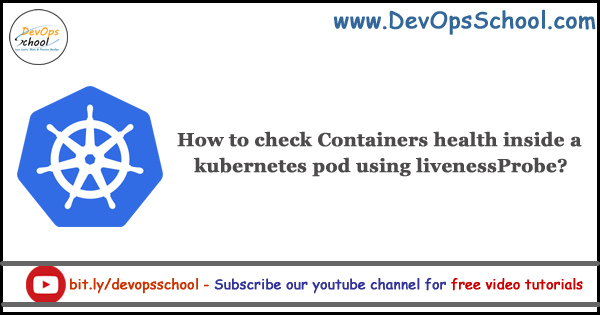
A Probe is a diagnostic performed periodically by the kubelet on a Container. To perform a diagnostic, the kubelet calls a Handler implemented by the Container. There are three types of handlers:
- ExecAction: Executes a specified command inside the Container. The diagnostic is considered successful if the command exits with a status code of 0.
- TCPSocketAction: Performs a TCP check against the Container’s IP address on a specified port. The diagnostic is considered successful if the port is open.
- HTTPGetAction: Performs an HTTP Get request against the Container’s IP address on a specified port and path. The diagnostic is considered successful if the response has a status code greater than or equal to 200 and less than 400.
Each probe has one of three results:
- Success: The Container passed the diagnostic.
- Failure: The Container failed the diagnostic.
- Unknown: The diagnostic failed, so no action should be taken.
The kubelet can perform and react to two kinds of probes on running Containers:
- livenessProbe: Indicates whether the Container is running. If the liveness probe fails, the kubelet kills the Container, and the Container is subjected to its restart policy. If a Container does not provide a liveness probe, the default state is Success.
- readinessProbe: Indicates whether the Container is ready to service requests. If the readiness probe fails, the endpoints controller removes the Pod’s IP address from the endpoints of all Services that match the Pod. The default state of readiness before the initial delay is Failure. If a Container does not provide a readiness probe, the default state is Success.
In this excercise, I would like to discuss on livenessProbe.
Here is the example for livenessProbe using ExecAction
apiVersion: v1
kind: Pod
metadata:
labels:
test: liveness
name: liveness-exec
spec:
containers:
- name: liveness
image: registry.k8s.io/busybox
args:
- /bin/sh
- -c
- touch /tmp/healthy; sleep 30; rm -f /tmp/healthy; sleep 600
livenessProbe:
exec:
command:
- cat
- /tmp/healthy
initialDelaySeconds: 5
periodSeconds: 5Code language: JavaScript (javascript)Here is the example for livenessProbe using TCPSocketAction
apiVersion: v1
kind: Service
metadata:
name: wordpress-mysql
labels:
app: wordpress
spec:
ports:
- port: 3306
selector:
app: wordpress
tier: mysql
clusterIP: None
---
apiVersion: v1
kind: PersistentVolumeClaim
metadata:
name: mysql-pv-claim
labels:
app: wordpress
spec:
accessModes:
- ReadWriteOnce
resources:
requests:
storage: 20Gi
---
apiVersion: apps/v1 # for k8s versions before 1.9.0 use apps/v1beta2 and before 1.8.0 use extensions/v1beta1
kind: Deployment
metadata:
name: wordpress-mysql
labels:
app: wordpress
spec:
selector:
matchLabels:
app: wordpress
tier: mysql
strategy:
type: Recreate
template:
metadata:
labels:
app: wordpress
tier: mysql
spec:
containers:
- image: mysql:5.6
name: mysql
env:
- name: MYSQL_ROOT_PASSWORD
valueFrom:
secretKeyRef:
name: mysql-pass
key: password
livenessProbe:
tcpSocket:
port: 3306
ports:
- containerPort: 3306
name: mysql
volumeMounts:
- name: mysql-persistent-storage
mountPath: /var/lib/mysql
volumes:
- name: mysql-persistent-storage
persistentVolumeClaim:
claimName: mysql-pv-claim
Code language: PHP (php)Here is the example for livenessProbe using HTTPGetAction
apiVersion: v1
kind: Service
metadata:
name: nginxsvc
labels:
app: nginx
spec:
type: NodePort
ports:
- port: 80
protocol: TCP
name: http
- port: 443
protocol: TCP
name: https
selector:
app: nginx
---
apiVersion: v1
kind: ReplicationController
metadata:
name: my-nginx
spec:
replicas: 1
template:
metadata:
labels:
app: nginx
spec:
volumes:
- name: secret-volume
secret:
secretName: nginxsecret
- name: configmap-volume
configMap:
name: nginxconfigmap
containers:
- name: nginxhttps
image: ymqytw/nginxhttps:1.5
command: ["/home/auto-reload-nginx.sh"]
ports:
- containerPort: 443
- containerPort: 80
livenessProbe:
httpGet:
path: /index.html
port: 80
initialDelaySeconds: 30
timeoutSeconds: 1
volumeMounts:
- mountPath: /etc/nginx/ssl
name: secret-volume
- mountPath: /etc/nginx/conf.d
name: configmap-volume
Code language: PHP (php)Define a liveness command
apiVersion: v1
kind: Pod
metadata:
labels:
test: liveness
name: liveness-exec
spec:
containers:
- name: liveness
image: k8s.gcr.io/busybox
args:
- /bin/sh
- -c
- touch /tmp/healthy; sleep 30; rm -rf /tmp/healthy; sleep 600
livenessProbe:
exec:
command:
- cat
- /tmp/healthy
initialDelaySeconds: 5
periodSeconds: 5
Define a liveness HTTP request
apiVersion: v1
kind: Pod
metadata:
labels:
test: liveness
name: liveness-http
spec:
containers:
- name: liveness
image: k8s.gcr.io/liveness
args:
- /server
livenessProbe:
httpGet:
path: /healthz
port: 8080
httpHeaders:
- name: X-Custom-Header
value: Awesome
initialDelaySeconds: 3
periodSeconds: 3
Here is the configuration file for the Pod:
apiVersion: v1
kind: Pod
metadata:
labels:
test: liveness
name: liveness-exec
spec:
containers:
- name: liveness
image: k8s.gcr.io/busybox
args:
- /bin/sh
- -c
- touch /tmp/healthy; sleep 30; rm -rf /tmp/healthy; sleep 600
livenessProbe:
exec:
command:
- cat
- /tmp/healthy
initialDelaySeconds: 5
periodSeconds: 5
Here is an example config for a Pod with an HTTP health check
apiVersion: v1
kind: Pod
metadata:
name: pod-with-http-healthcheck
spec:
containers:
- name: nginx
image: nginx
# defines the health checking
livenessProbe:
# an http probe
httpGet:
path: /_status/healthz
port: 80
# length of time to wait for a pod to initialize
# after pod startup, before applying health checking
initialDelaySeconds: 30
timeoutSeconds: 1
ports:
- containerPort: 80
And here is an example config for a Pod with a TCP Socket health check
apiVersion: v1
kind: Pod
metadata:
name: pod-with-tcp-socket-healthcheck
spec:
containers:
- name: redis
image: redis
# defines the health checking
livenessProbe:
# a TCP socket probe
tcpSocket:
port: 6379
# length of time to wait for a pod to initialize
# after pod startup, before applying health checking
initialDelaySeconds: 30
timeoutSeconds: 1
ports:
- containerPort: 6379
apiVersion: extensions/v1beta1
kind: Deployment
metadata:
name: helloworld-deployment
spec:
replicas: 3
template:
metadata:
labels:
app: helloworld
spec:
containers:
- name: k8s-demo
image: wardviaene/k8s-demo
ports:
- name: nodejs-port
containerPort: 3000
livenessProbe:
httpGet:
path: /
port: nodejs-port
initialDelaySeconds: 15
timeoutSeconds: 30Code language: PHP (php)I’m a DevOps/SRE/DevSecOps/Cloud Expert passionate about sharing knowledge and experiences. I am working at Cotocus. I blog tech insights at DevOps School, travel stories at Holiday Landmark, stock market tips at Stocks Mantra, health and fitness guidance at My Medic Plus, product reviews at I reviewed , and SEO strategies at Wizbrand.
Do you want to learn Quantum Computing?
Please find my social handles as below;
Rajesh Kumar Personal Website
Rajesh Kumar at YOUTUBE
Rajesh Kumar at INSTAGRAM
Rajesh Kumar at X
Rajesh Kumar at FACEBOOK
Rajesh Kumar at LINKEDIN
Rajesh Kumar at PINTEREST
Rajesh Kumar at QUORA
Rajesh Kumar at WIZBRAND

